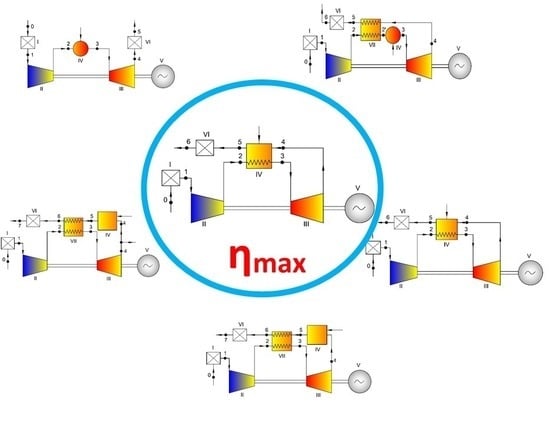Influence of Different Biofuels on the Efficiency of Gas Turbine Cycles for Prosumer and Distributed Energy Power Plants
Abstract
:1. Introduction
2. Materials and Methods
The Computation Algorithm
- Variant 1: turbine set operating according to the simple open cycle,
- Variant 2: turbine set operating according to the open cycle with regenerator,
- Variant 3: turbine set operating according to the open cycle with combustion chamber at turbine exit,
- Variant 4: turbine set operating according to the open cycle with external combustion chamber at turbine exit and high-temperature heat exchanger,
- Variant 5: turbine set operating according to the open cycle with partial bypassing of external combustion chamber at turbine exit and with high-temperature heat exchanger.
3. Results
4. Discussion
5. Final Conclusions
- In the design of the flow part of gas turbines that burn biofuel (mainly low power ones, dedicated for distributed energetics), not only the structure of the turbine set, but also the calorific value and type of fuel should be taken into account.
- Variant 3 is the most-advantageous system due to the efficiency achieved; it allows for increasing the efficiency with respect to the reference value of variant 1 by even over 70%. Also, higher values are obtained for fuels with higher heating values (Figure 11).
- The type of fuel affects the cycle efficiency for variant 1 and variant 4 as well as variant 5 (Figure 12). In the case of variant 1, an increase in calorific value reduces efficiency (up to 30%) as related to the efficiency of the cycle with methane as a fuel, while in variant 4 and variant 5 an increase in calorific value increases (up to 20%) the efficiency related to the efficiency of the cycle with methane as a fuel.
- The change in calorific value has a very significant impact on the amount of fuel combusted in the combustion chamber (Figure 13); e.g., for a very low heating value (Wd = 4 MJ/kg), the amount of fuel burned increases by up to 20 times compared to the combusted methane (Wd = 54.1 MJ/kg).
- For fuels with very low calorific values (Wd = 4 MJ/kg and Wd = 8.5 MJ/kg), a clear change in the mass flux of flue gas flowing through the turbine as related to the exhaust mass flux of methane as fuel (Figure 14) can be observed; in other cases this change is minor.
- For variant 1 and variant 2, the effect of calorific value on the effective power referring to effective power with methane used as a fuel (Figure 15) can be seen, while in the remaining variants the heating value of the fuel shows minimal or no effect on the effective power of the turbine set.
Author Contributions
Funding
Conflicts of Interest
Nomenclature and Units
| l | work of unit mass | (kJ/kg) |
| h | enthalpy of unit mass | (kJ/kg) |
| LHV | lower heating value | (MJ/kg) |
| ∏ | compression ratio | (-) |
| cp | specific heat at constant pressure | (kJ/kg·K) |
| i | enthalpy of unit mass | (kJ/kg) |
| m | mass flow rate | (kg/s) |
| W | power | (kW) |
| p | pressure | (Pa) |
| Q | heat flux | (kW) |
| R | gas constant | (kJ/kg·K) |
| s | entropy of unit mass; also: blade pitch | (kJ/kg·K); (mm) |
| T | temperature | (ᵒC) |
| v | specific volume | (m3/kg) |
| Wd | calorific value | (MJ/m3) or (MJ/kg); |
| η | efficiency | (-) |
| κ | isentropic exponent | (-) |
| e | an effective |
| hyd | hydrogen |
| G | generator |
| i | internal |
| j | unit |
| C | compressor |
| CC | combustion chamber |
| m | mechanical |
| meth | methane |
| n | leaks |
| ob | cycle |
| opt | optimal |
| spal | exhaust gas |
| T | turbine |
| GT | gas turbine set |
| 1, 2,… | point numbers on diagrams |
References
- Magazzino, C. Electricity Demand, GDP and Employment: Evidence from Italy. Front. Energy 2014, 8, 31–40. [Google Scholar] [CrossRef]
- Magazzino, C. Stationarity of electricity series in MENA countries. Electr. J. 2017, 30, 16–22. [Google Scholar] [CrossRef]
- Herran, D.S.; Tachiiri, K.; Matsumoto, K. Global energy system transformations in mitigation scenarios considering climate uncertainties. Appl. Energy 2019, 243, 119–131. [Google Scholar] [CrossRef]
- Veum, K.; Bauknecht, D. How to reach the EU renewables target by 2030? An analysis of the governance framework. Energy Policy 2019, 127, 299–307. [Google Scholar] [CrossRef]
- Wierzbowski, M.; Filipiak, I.; Lyzwa, W. Polish energy policy 2050—An instrument to develop a diversified and sustainable electricity generation mix in coal-based energy system. Renew. Sustain. Energy Rev. 2017, 74, 51–70. [Google Scholar] [CrossRef]
- Tucki, K.; Orynycz, O.; Wasiak, A.; Świć, A.; Dybaś, W. Capacity market implementation in Poland: Analysis of a survey on consequences for the electricity market and for energy management. Energies 2019, 12, 839. [Google Scholar] [CrossRef]
- European Electricity Market—Diagnosis 2018. Available online: https://www.pse.pl/web/pse-eng/-/the-diagnosis-of-the-european-electricity-market-from-the-point-of-view-of-the-polish-transmission-system-operator (accessed on 24 July 2019).
- Brown, T.; Schlachtberger, D.; Kies, A.; Schramm, S.; Greiner, M. Synergies of sector coupling and transmission reinforcement in a cost-optimised, highly renewable European energy system. Energy 2018, 160, 720–739. [Google Scholar] [CrossRef] [Green Version]
- Dusonchet, L.; Favuzza, S.; Massaro, F.; Telaretti, E.; Zizzo, G. Technological and legislative status point of stationary energy storages in the EU. Renew. Sustain. Energy Rev. 2019, 101, 158–167. [Google Scholar] [CrossRef]
- The Model of the Optimal Energy Mix for Poland by 2060. Chancellery of the Prime Minister. Available online: https://www.premier.gov.pl/en/news/news/the-model-of-an-optimal-energy-mix-for-poland-by-2060.html (accessed on 24 July 2019).
- Renn, O.; Marshall, J.P. Coal, nuclear and renewable energy policies in Germany: From the 1950s to the “Energiewende”. Energy Policy 2016, 99, 224–232. [Google Scholar] [CrossRef]
- Anifantis, A.S.; Colantoni, A.; Pascuzzi, S.; Santoro, F. Photovoltaic and Hydrogen Plant Integrated with a Gas Heat Pump for Greenhouse Heating: A Mathematical Study. Sustainability 2018, 10, 378. [Google Scholar] [CrossRef]
- Tucki, K.; Orynycz, O.; Świć, A.; Mitoraj-Wojtanek, M. The development of electromobility in Poland and EU States as a tool for management of CO2 emission. Energies 2019, 12, 2942. [Google Scholar] [CrossRef]
- Caragliu, A.; Del Bo, C.F. Smart innovative cities: The impact of Smart City policies on urban innovation. Technol. Forecast. Soc. Chang. 2019, 142, 373–383. [Google Scholar] [CrossRef]
- Haarstad, H.; Wathne, M.W. Are smart city projects catalyzing urban energy sustainability? Energy Policy 2019, 129, 918–925. [Google Scholar] [CrossRef]
- Tucki, K.; Sikora, M. Technical and logistics analysis of the extension of the energy supply system with the cogeneration unit supplied with biogas from the water treatment plant. TEKA Comm. Motorization Power Ind. Agric. 2016, 16, 71–75. [Google Scholar]
- Raymundo, H.; Dos Reis, J.G.M. Measures for Passenger-Transport Performance Evaluation in Urban Areas. J. Urban Plan. Dev. 2018, 144, 04018023. [Google Scholar] [CrossRef]
- Halkos, G.; Tsilika, K. Understanding transboundary air pollution network: Emissions, depositions and spatio-temporal distribution of pollution in European region. Resour. Conserv. Recycl. 2019, 145, 113–123. [Google Scholar] [CrossRef]
- Gawlik, L.; Szurlej, A.; Wyrwa, A. The impact of the long-term EU target for renewables on the structure of electricity production in Poland. Energy 2015, 92, 172–178. [Google Scholar] [CrossRef]
- Tucki, K.; Mruk, R.; Orynycz, O.; Wasiak, A.; Botwińska, K.; Gola, A. Simulation of the Operation of a Spark Ignition Engine Fueled with Various Biofuels and Its Contribution to Technology Management. Sustainability 2019, 11, 2799. [Google Scholar] [CrossRef]
- Tucki, K.; Orynycz, O.; Wasiak, A.; Swic, A.; Wichlacz, J. The Impact of Fuel Type on the Output Parameters of a New Biofuel Burner. Energies 2019, 12, 1383. [Google Scholar] [CrossRef]
- García-Álvarez, M.T.; Moreno, B. Environmental performance assessment in the EU: A challenge for the sustainability. J. Clean. Prod. 2018, 205, 266–280. [Google Scholar] [CrossRef]
- Capros, C.; Kannavou, M.; Evangelopoulou, S.; Petropoulos, A.; Siskos, P.; Tasios, N.; Zazias, G.; DeVita, A. Outlook of the EU energy system up to 2050: The case of scenarios prepared for European Commission’s “clean energy for all Europeans” package using the PRIMES model. Energy Strategy Rev. 2018, 22, 255–263. [Google Scholar] [CrossRef]
- Report on the Polish Power System Vision 2.0 Century Profile. Available online: https://www.agora-energiewende.de/en/ (accessed on 24 July 2019).
- Kosowski, K.; Tucki, K.; Piwowarski, M.; Stepien, R.; Orynycz, O.; Wlodarski, W. Thermodynamic Cycle Concepts for High-Efficiency Power Plants. Part B: Prosumer and Distributed Power Industry. Sustainability 2019, 11, 2647. [Google Scholar] [CrossRef]
- Bel, G.; Joseph, S. Climate change mitigation and the role of technological change: Impact on selected headline targets of Europe’s 2020 climate and energy package. Renew. Sustain. Energy Rev. 2018, 82, 3798–3807. [Google Scholar] [CrossRef]
- Adamczyk, J.; Dzikuć, M. The analysis of suppositions included in the Polish Energetic Policy using the LCA technique—Poland case study. Renew. Sustain. Energy Rev. 2014, 39, 42–50. [Google Scholar] [CrossRef]
- Moslehi, S.; Reddy, T.A. An LCA methodology to assess location-specific environmental externalities of integrated energy systems. Sustain. Cities Soc. 2019, 46, 1–14. [Google Scholar] [CrossRef]
- Cellura, M.; Cusenza, M.A.; Longo, S. Energy-related GHG emissions balances: IPCC versus LCA. Sci. Total Environ. 2018, 628, 1328–1339. [Google Scholar] [CrossRef]
- Cepeda, M. Assessing cross-border integration of capacity mechanisms in coupled electricity markets. Energy Policy 2018, 119, 28–40. [Google Scholar] [CrossRef]
- Manowska, A.; Tobór-Osadnik, K.; Wyganowska, M. Economic and social aspects of restructuring Polish coal mining: Focusing on Poland and the EU. Resour. Policy 2017, 52, 192–200. [Google Scholar] [CrossRef]
- Palm, J.; Eidenskog, M.; Luthander, R. Sufficiency, change, and flexibility: Critically examining the energy consumption profiles of solar PV prosumers in Sweden. Energy Res. Soc. Sci. 2018, 39, 12–18. [Google Scholar] [CrossRef]
- Zafar, R.; Mahmood, A.; Razzaq, S.; Ali, W.; Naeem, U.; Shehzad, K. Prosumer based energy management and sharing in smart grid. Renew. Sustain. Energy Rev. 2018, 82, 1675–1684. [Google Scholar] [CrossRef]
- Picchi, P.; Van Lierop, M.; Geneletti, D.; Stremke, S. Advancing the relationship between renewable energy and ecosystem services for landscape planning and design: A literature review. Ecosyst. Serv. 2019, 35, 241–259. [Google Scholar] [CrossRef]
- Van Aubel, P.; Poll, E. Smart metering in the Netherlands: What, how, and why. Int. J. Electr. Power Energy Syst. 2019, 109, 719–725. [Google Scholar] [CrossRef] [Green Version]
- Wang, Y.; Qiu, H.; Tu, Y.; Liu, Q.; Ding, Y.; Wang, W. A Review of Smart Metering for Future Chinese Grids. Energy Procedia 2018, 152, 1194–1199. [Google Scholar] [CrossRef]
- Jurasz, J.; Dąbek, P.B.; Kaźmierczak, B.; Kies, A.; Wdowikowski, M. Large scale complementary solar and wind energy sources coupled with pumped-storage hydroelectricity for Lower Silesia (Poland). Energy 2018, 161, 183–192. [Google Scholar] [CrossRef]
- Badyda, K.; Niewiński, G.G.; Patrycy, A.; Orzeszek, W. Attempt to Estimate the Costs of Implementing BAT Conclusions for Large Combustion Plants. Soc. Inequal. Econ. Growth 2016, 46, 315–333. [Google Scholar]
- Calise, F.; De Notaristefani di Vastogirardi, G.; D’Accadia, M.D.; Vicidomini, M. Simulation of polygeneration systems. Energy 2018, 163, 290–337. [Google Scholar] [CrossRef]
- Jarnut, M.; Wermiński, S.; Waśkowicz, B. Comparative analysis of selected energy storage technologies for prosumer-owned microgrids. Renew. Sustain. Energy Rev. 2017, 74, 925–937. [Google Scholar] [CrossRef]
- Aiying, R.; Risto, L. Role of polygeneration in sustainable energy system development: Challenges and opportunities from optimization viewpoints. Renew. Sustain. Energy Rev. 2016, 53, 363–372. [Google Scholar]
- Murugan, S.; Horák, B. Tri and polygeneration systems—A review. Renew. Sustain. Energy Rev. 2016, 60, 1032–1051. [Google Scholar] [CrossRef]
- Chmielak, T.; Ziębik, A. Obiegi Cieplne Nadkrytycznych Bloków Węglowych; Wydawnictwo Politechniki Śląskiej: Gliwice, Poland, 2010; pp. 19–43. (In Polish) [Google Scholar]
- Lampart, P.; Kosowski, K.; Piwowarski, M.; Jędrzejewski, L. Design analysis of tesla micro-turbine operating on a low-boiling medium. Pol. Marit. Res. 2009, 1, 28–33. [Google Scholar] [CrossRef]
- Mikielewicz, J.; Piwowarski, M.; Kosowski, K. Design analysis of turbines for co-generating micro-power plant working in accordance with organic rankine’s cycle. Pol. Marit. Res. 2009, 1, 34–38. [Google Scholar] [CrossRef]
- Piwowarski, M.; Kosowski, K. Design analysis of combined gas-vapour micro power plant with 30 kw air turbine. Pol. J. Environ. Stud. 2014, 23, 1397–1401. [Google Scholar]
- Turbines Markets 2016–2024: Steam, Gas Turbines, Wind, Others—Global Strategic Business Report 2018. Available online: https://markets.businessinsider.com/news/stocks/turbines-markets-2016-2024-steam-gas-turbines-wind-others-global-strategic-business-report-2018-1021662041 (accessed on 18 August 2019).
- Stępniak, D.; Piwowarski, M. Analyzing selection of low-temperature medium for cogeneration micro power plant. Pol. J. Environ. Stud. 2014, 23, 1417–1421. [Google Scholar]
- Weiß, A.P.; Popp, T.; Zinn, G.; Preißinger, M.; Brüggemann, D. A micro-turbine-generator-construction-kit (MTG-c-kit) for small-scale waste heat recovery ORC-Plants. Energy 2019, 181, 51–55. [Google Scholar] [CrossRef]
- Herrando, M.; Pantaleo, A.M.; Wang, K.; Markides, C.N. Solar combined cooling, heating and power systems based on hybrid PVT, PV or solar-thermal collectors for building applications. Renew. Energy 2019, 143, 637–647. [Google Scholar] [CrossRef]
- Hsu, P.C.; Huang, B.J.; Wu, P.H.; Wu, W.H.; Lee, M.J.; Yeh, J.F.; Wang, Y.H.; Tsai, J.H.; Li, K.; Lee, K.Y. Long-term Energy Generation Efficiency of Solar PV System for Self-consumption. Energy Procedia 2017, 141, 91–95. [Google Scholar] [CrossRef]
- Samson, I.; Sikora, M.; Bączyk, A.; Mączyńska, J.; Tucki, K. Technologies used to enhance the biogas and biomethane yield: A review. Przemysł Chem. 2017, 96, 1605–1611. [Google Scholar]
- Saadabadi, S.A.; Thattai, A.T.; Fan, L.; Lindeboom, R.E.F.; Spanjers, H.; Aravind, P.V. Solid Oxide Fuel Cells fuelled with biogas: Potential and constraints. Renew. Energy 2019, 134, 194–214. [Google Scholar] [CrossRef]
- Tonini, D.; Hamelin, L.; Alvarado-Morales, M.; Astrup, T.F. GHG emission factors for bioelectricity, biomethane, and bioethanol quantified for 24 biomass substrates with consequential life-cycle assessment. Bioresour. Technol. 2016, 208, 123–133. [Google Scholar] [CrossRef] [Green Version]
- Shen, X.; Kommalapati, R.R.; Huque, Z. The Comparative Life Cycle Assessment of Power Generation from Lignocellulosic Biomass. Sustainability 2015, 7, 12974–12987. [Google Scholar] [CrossRef] [Green Version]
- Adelt, M.; Wolf, D.; Vogel, A. LCA of biomethane. J. Nat. Gas Sci. Eng. 2011, 3, 646–650. [Google Scholar] [CrossRef]
- Gonzalez-Fernandez, C.; Sialve, B.; Bernet, N.; Steyer, J.P. Impact of microalgae characteristics on their conversion to biofuel. Part ii: Focus on biomethane production. Biofuels Bioprod. Biorefin. 2012, 6, 205–218. [Google Scholar] [CrossRef]
- Cozzolino, R.; Lombardi, L.; Tribioli, L. Use of biogas from biowaste in a solid oxide fuel cell stack: Application to an off-grid power plant. Renew. Energy 2017, 111, 781–791. [Google Scholar] [CrossRef]
- Hijazi, O.; Tappen, S.; Effenberger, M. Environmental impacts concerning flexible power generation in a biogas production. Carbon Resour. Convers. 2019, 2, 117–125. [Google Scholar] [CrossRef]
- Barbuzza, E.; Buceti, G.; Pozio, A.; Santarelli, M.; Tosti, S. Gasification of wood biomass with renewable hydrogen for the production of synthetic natural gas. Fuel 2019, 242, 520–531. [Google Scholar] [CrossRef]
- Coronado, C.R.; Yoshioka, J.T.; Silveira, J.L. Electricity, hot water and cold water production from biomass. Energetic and economical analysis of the compact system of cogeneration run with woodgas from a small downdraft gasifier. Renew. Energy 2011, 36, 1861–1868. [Google Scholar] [CrossRef] [Green Version]
- Kosowski, K.; Domachowski, Z.; Próchnicki, W.; Kosowski, A.; Stępień, R.; Piwowarski, M.; Włodarski, W.; Ghaemi, M.; Tucki, K.; Gardzilewicz, A.; et al. Steam and Gas Turbines with the Examples of Alstom Technology, 1st ed.; Alstom: Saint-Quen, France, 2007; ISBN 978-83-925959-3-9. [Google Scholar]
- Kosowski, K.; Tucki, K.; Piwowarski, M.; Stępień, R.; Orynycz, O.; Włodarski, W.; Bączyk, A. Thermodynamic Cycle Concepts for High-Efficiency Power Plans. Part A: Public Power Plants 60+. Sustainability 2019, 11, 2647. [Google Scholar] [CrossRef]
- Ślefarski, R.; Jójka, J.; Czyżewski, P.; Grzymisławski, P. Experimental investigation on syngas reburning process in a gaseous fuel firing semi-industrial combustion chamber. Fuel 2018, 217, 490–498. [Google Scholar] [CrossRef]
- Taler, J.; Mruk, A.; Cisek, J.; Majewski, K. Combined heat and power plant with internal combustion engine fuelled by wood gas. Rynek Energii 2013, 4, 62–67. [Google Scholar]
- Kordylewski, W. Spalanie i paliwa, 5th ed.; Oficyna Wydawnicza Politechniki Wrocławskiej: Wrocław, Polska, 2008; pp. 10–470. ISBN 978-83-7493-378-0. [Google Scholar]
- Masłow, L.A. Ship Gas Turbines, 1st ed.; Sudostroene: Leningrad Region, Russia, 1973. (In Russian) [Google Scholar]
- Kostiuk, A.G.; Serstiuk, A.N. Gas Turbines Units, 1st ed.; Wyschaya Skola: Moscow, Russia, 1979. (In Russian) [Google Scholar]
- Traupel, W. Thermische Turbomachinen, 2nd ed.; Springer: Berlin/Heidelberg, Germany; New York, NY, USA, 1982; pp. 122–525. Available online: https://link.springer.com/book/10.1007%2F978-3-642-96632-3 (accessed on 12 August 2019).
- Sawyer, J.W. Gas Turbine Engineering Handbook, 3rd ed.; Turbomachinery International Publications: Norwalk, CT, USA, 1985; pp. 98–245. ISBN 0-937506-14-1. [Google Scholar]
- Sorensen, H.A. Gas Turbines (Series in Mechanical Engineering), 1st ed.; Ronald Press Company: New York, NY, USA, 1951; pp. 48–440. [Google Scholar]
- Gailfuß, M. Private meets Public—Small scale CHP. Technological Developments. In Proceedings of the Workshop BHKW-Infozentrum Rastatt, Berlin, Germany, 9 September 2003. [Google Scholar]
- Kosowski, K.; Włodarski, W.; Piwowarski, M.; Stepień, R. Performance characteristics of a micro-turbine. Adv. Vib. Eng. 2014, 2, 341–350. [Google Scholar]
- Kosowski, K.; Piwowarski, M.; Stępień, R.; Włodarski, W. Design and investigations of the ethanol microturbine. Arch. Thermodyn. 2018, 39, 41–54. [Google Scholar]
- AE-T100 Externally Fired Micro Turbine. Available online: https://www.ansaldoenergia.com/business-lines/new-units/microturbines/ae-t100e (accessed on 9 August 2019).
- High Reliability and Easy Maintenance. Technical Data for Dresser-Rand KG2 Gas Turbines. Available online: https://new.siemens.com/global/en/products/energy/power-generation/gas-turbines/dresser-rand-kg2.html (accessed on 9 August 2019).
- 1.2 MW Gas Turbine for Biomass Burning. Available online: https://www.braytonenergy.net/our-projects/1-2-mw-gas-turbine/ (accessed on 9 August 2019).
- Gas Turbine Electric Power Plant of External Combustion 2.5 MW GTEUVS-2.5MS. Available online: http://www.motorsich.com/eng/products/land/vrazrabotke/gteuvc-2.5ms/ (accessed on 9 August 2019).
- C65. Available online: https://www.capstoneturbine.com/products/c65 (accessed on 9 August 2019).


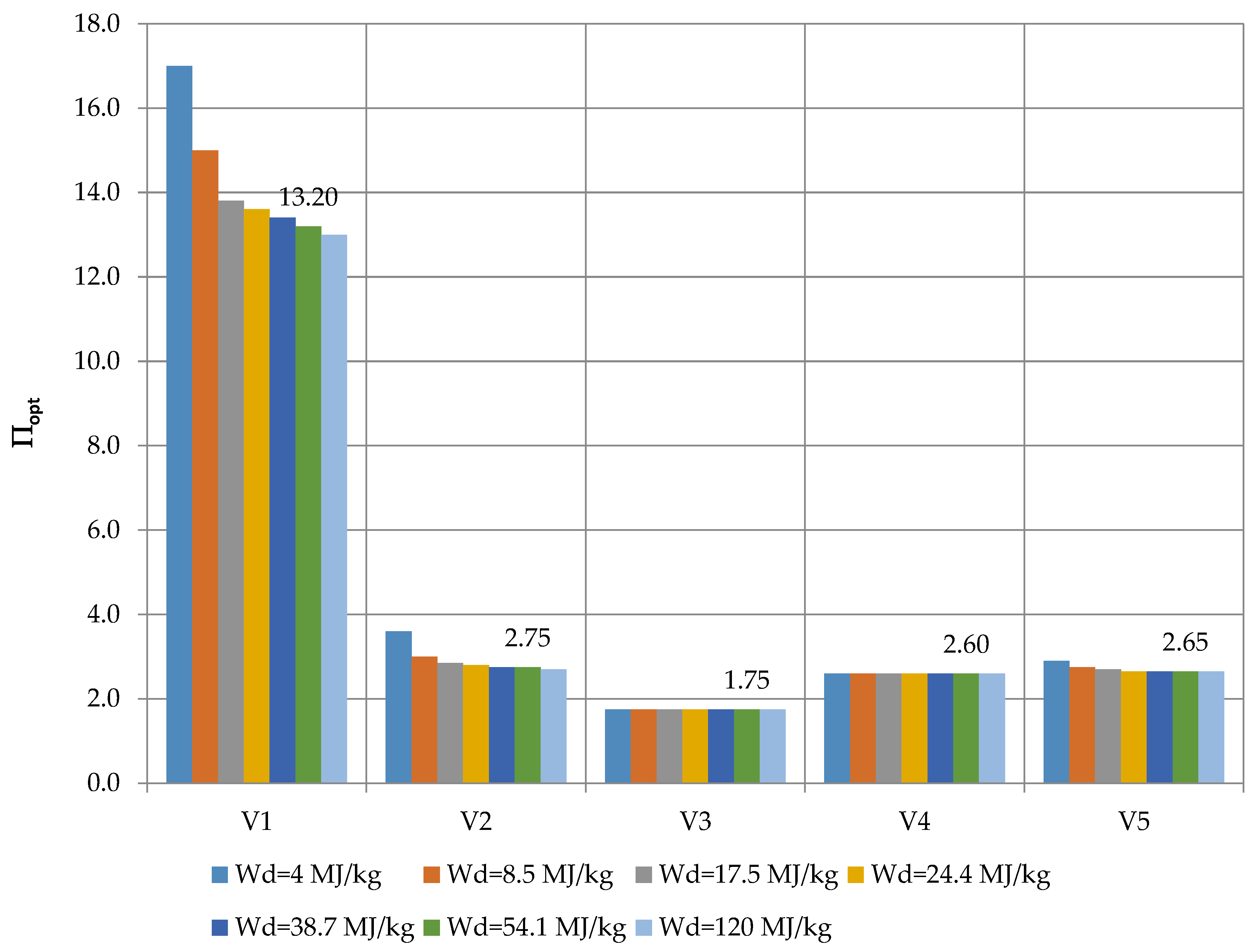
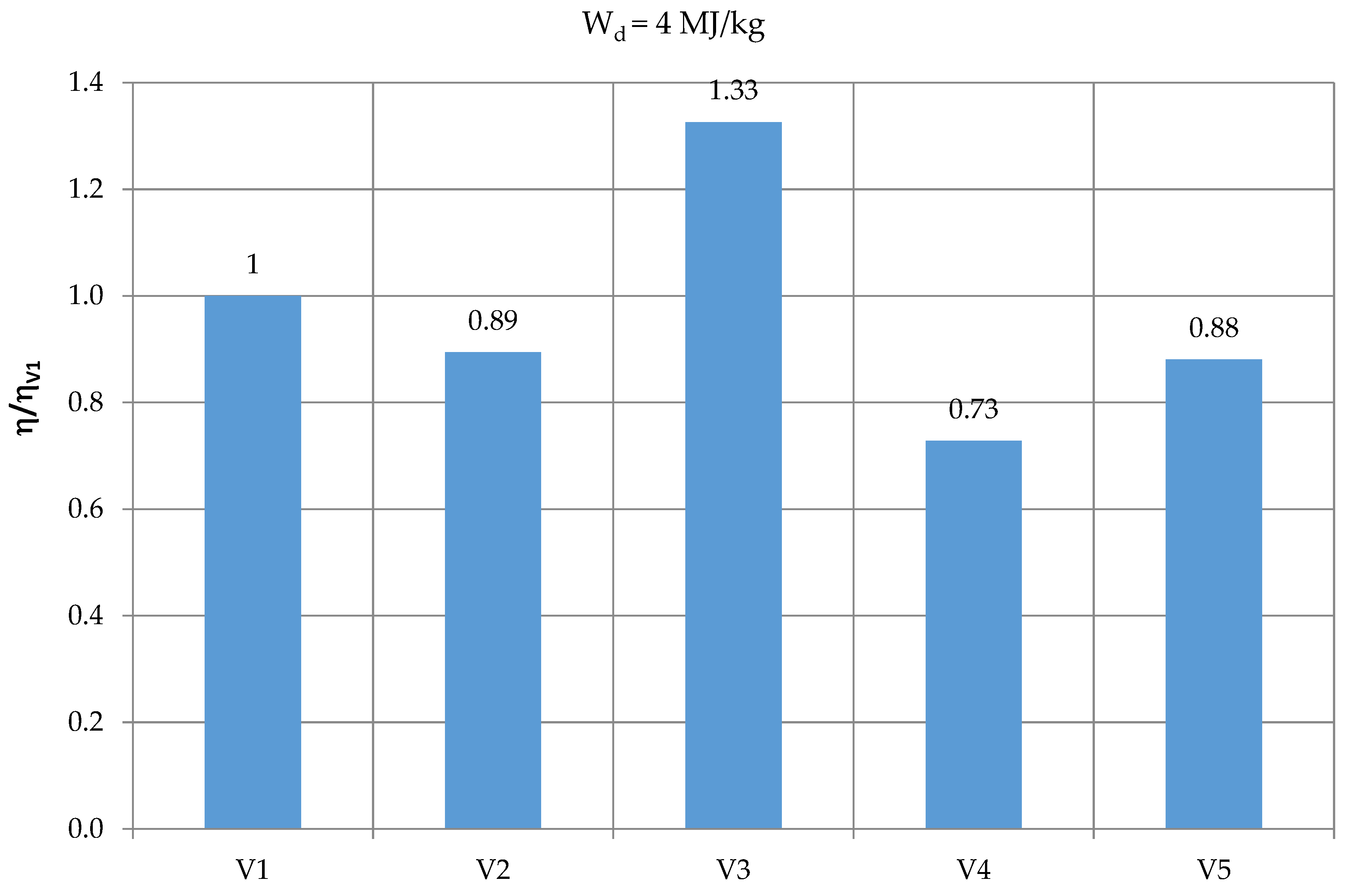

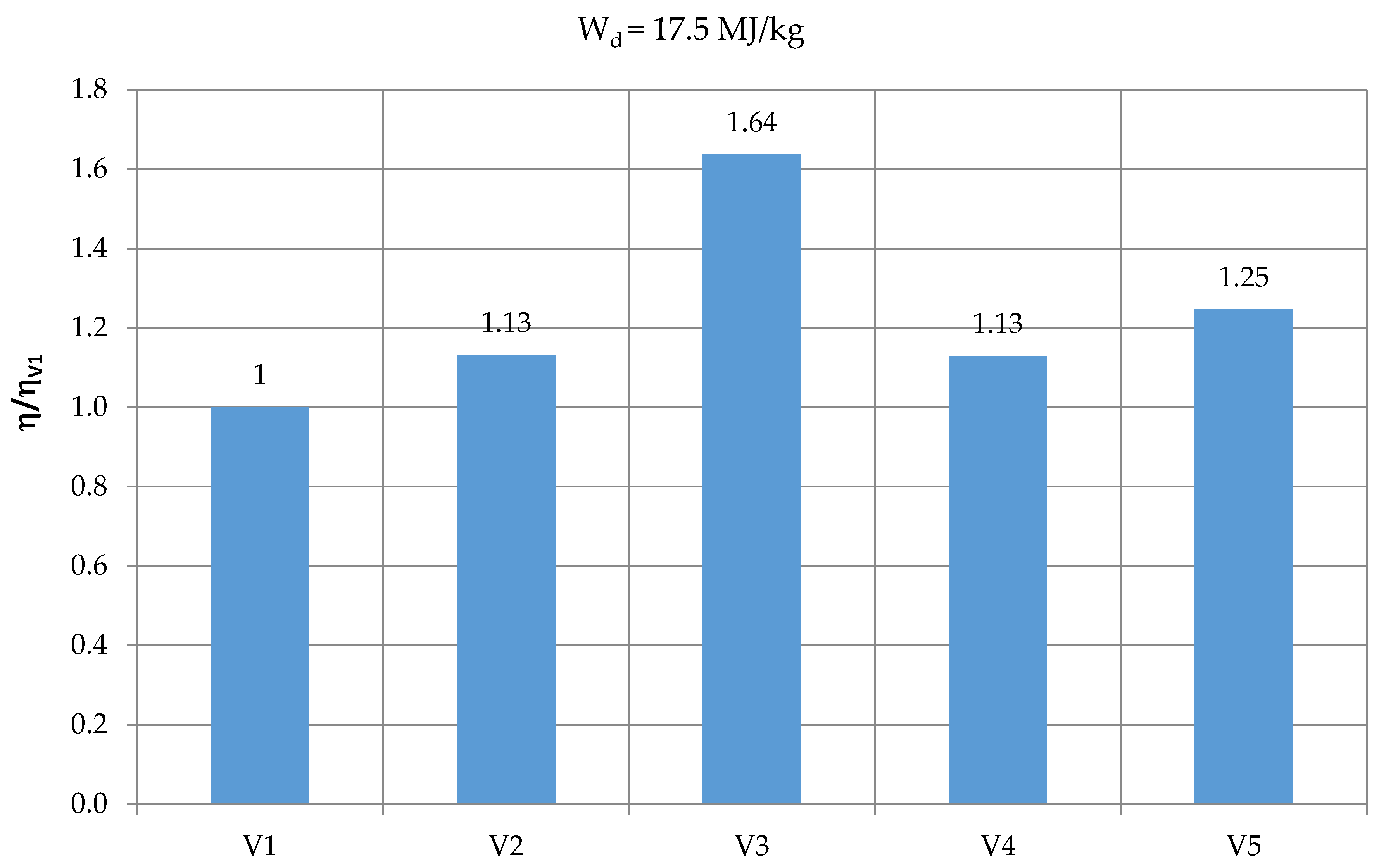
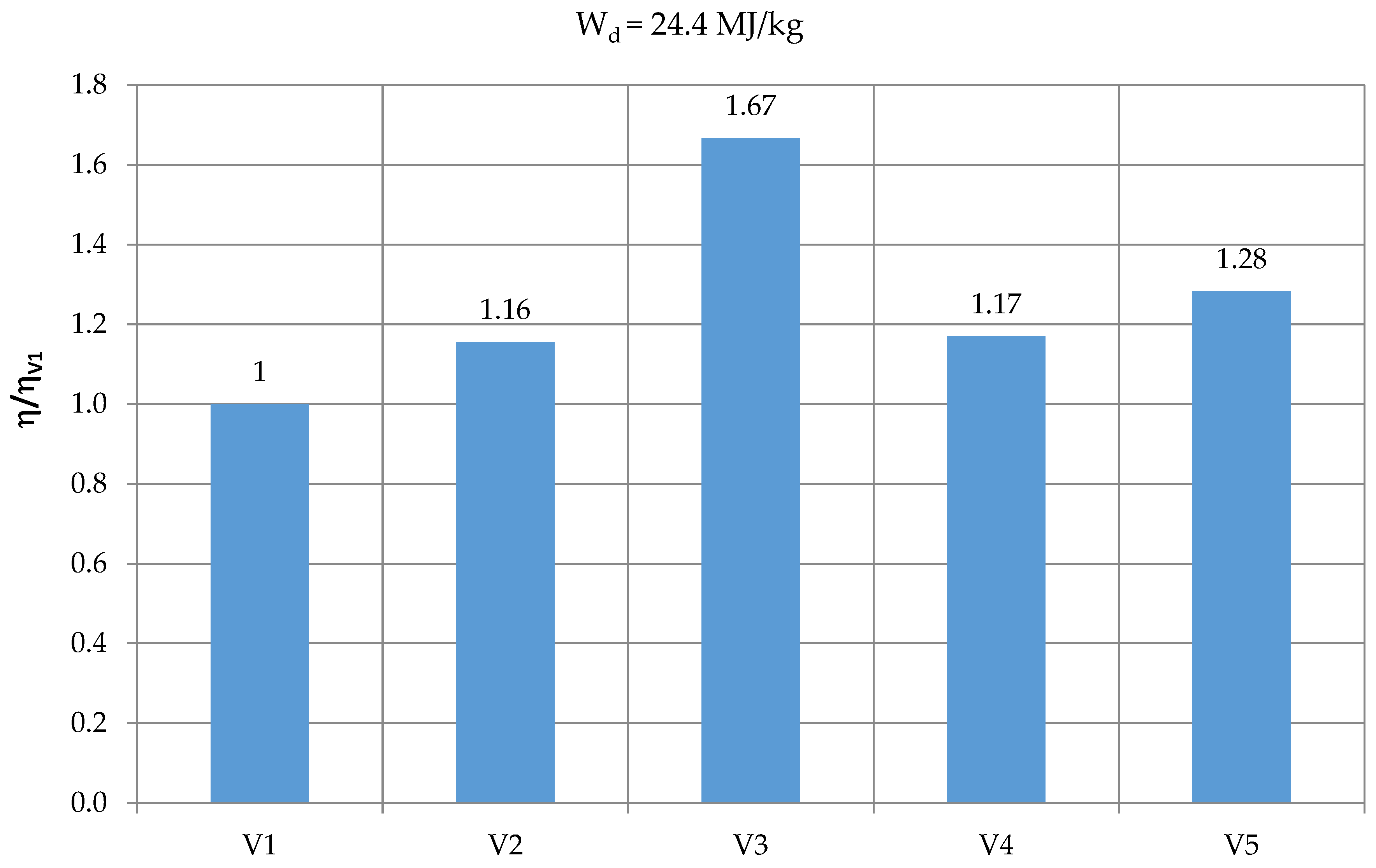
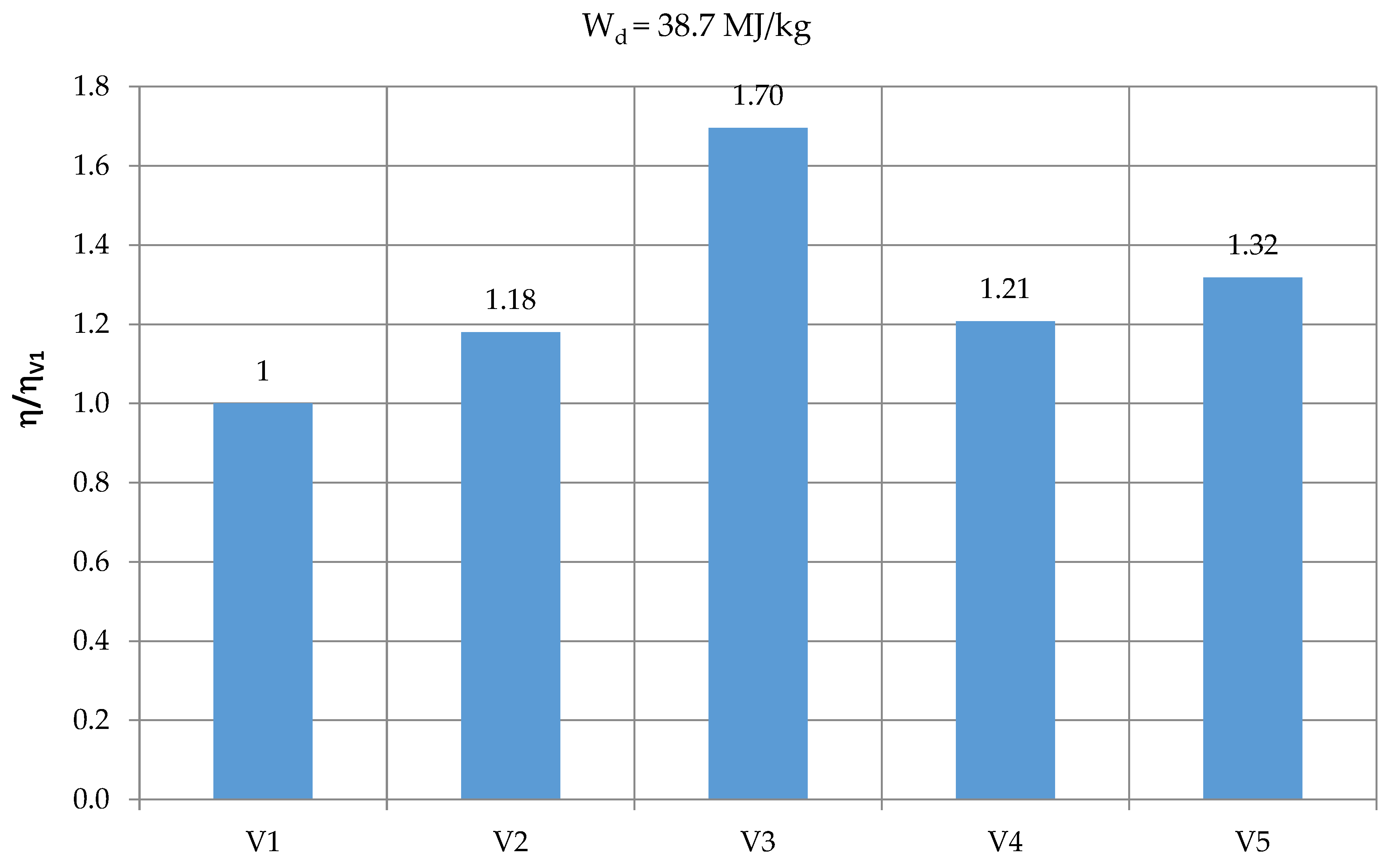
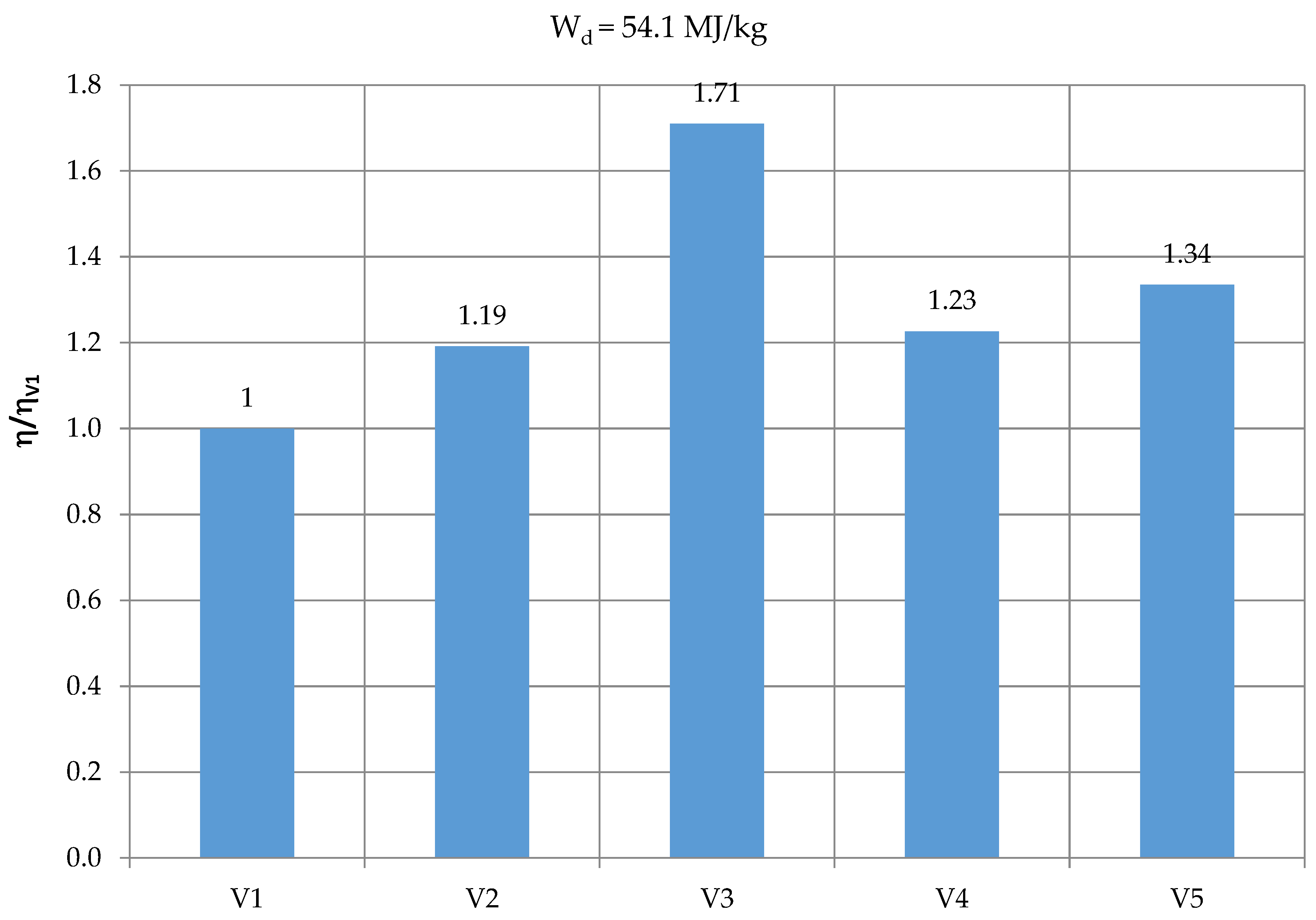

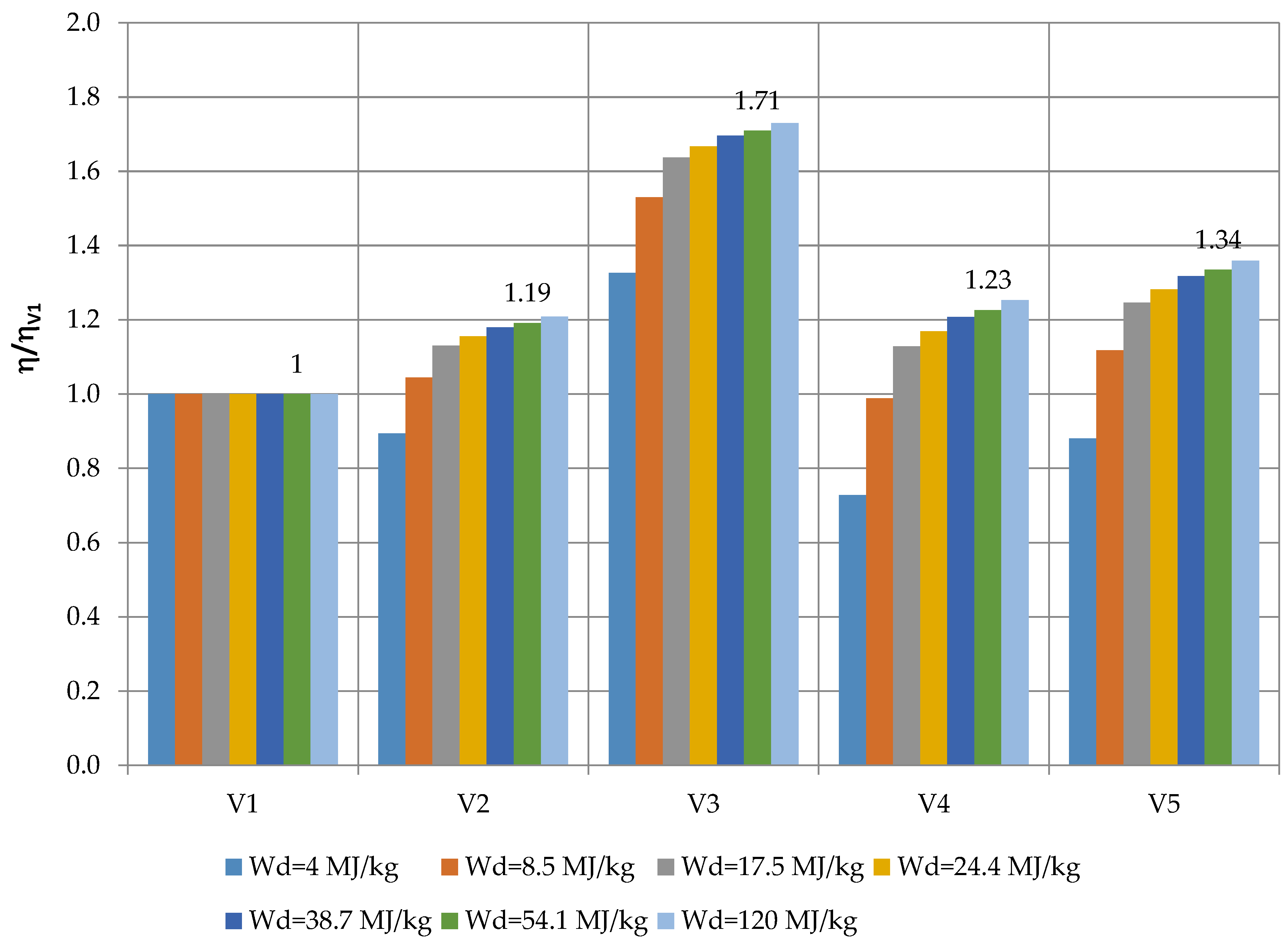

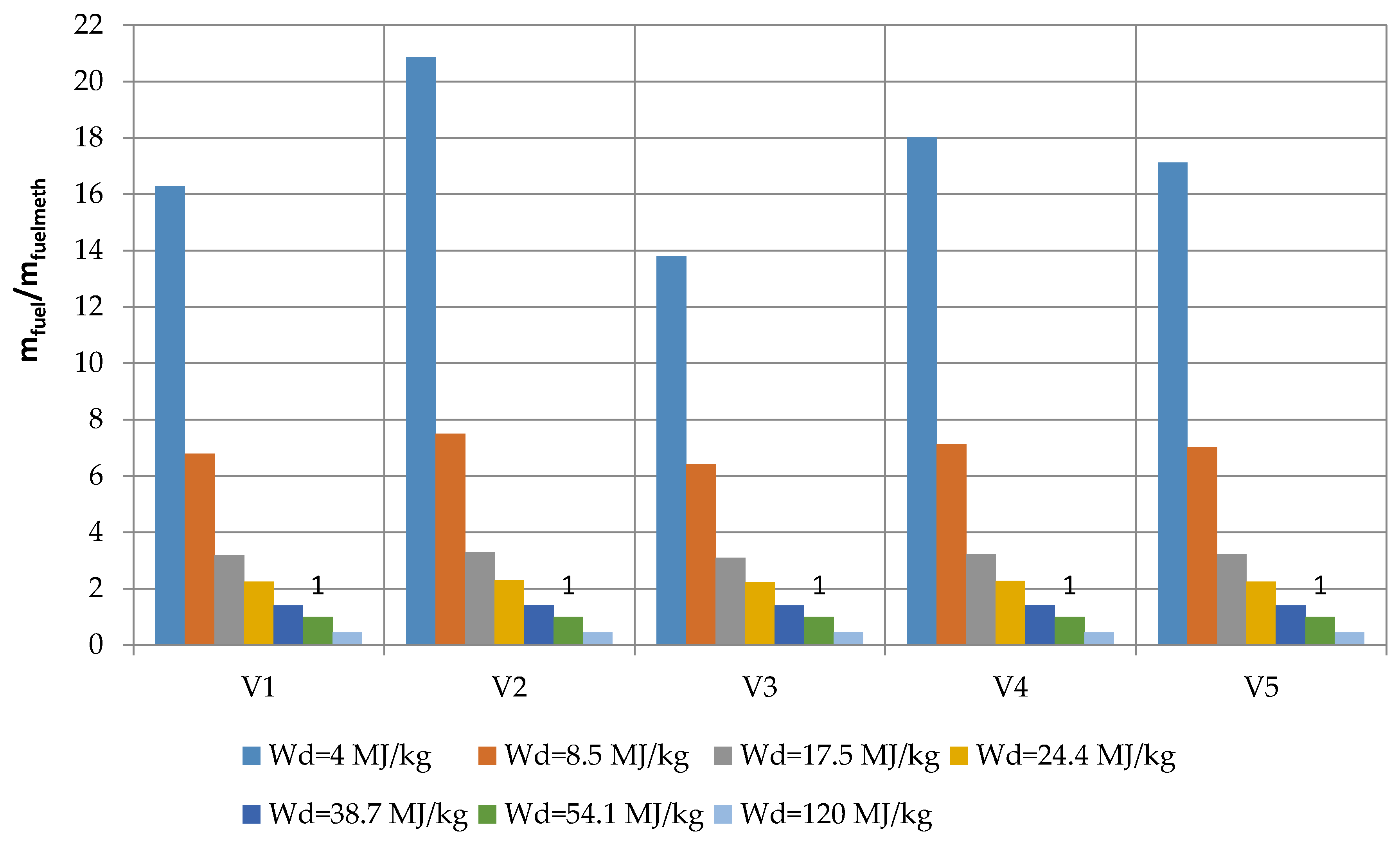
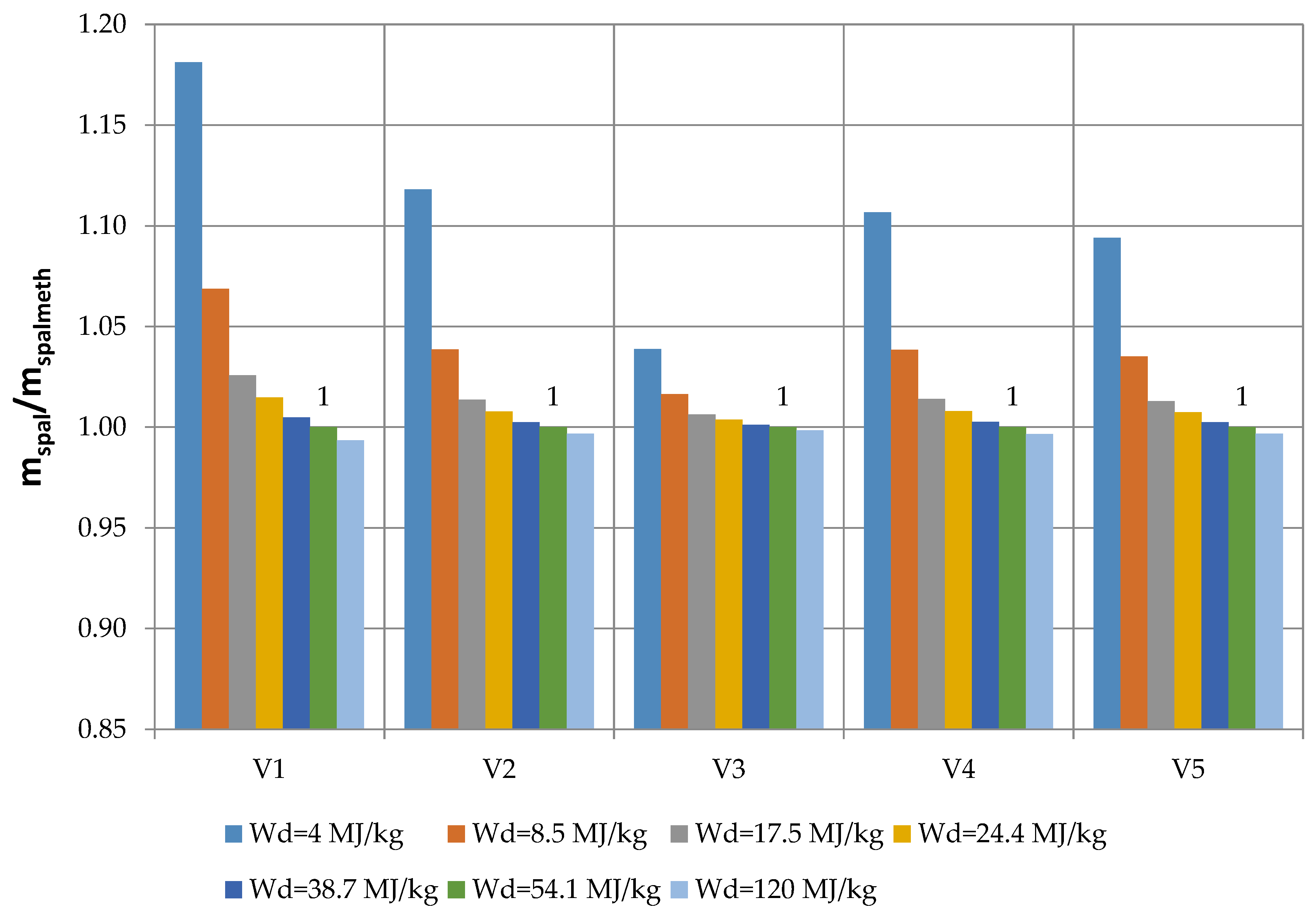

| Description | Unit | Value |
|---|---|---|
| compressor efficiency | (-) | 0.800 |
| turbine efficiency | (-) | 0.820 |
| mechanical efficiency | (-) | 0.980 |
| leakage losses | (-) | 0.020 |
| generator efficiency | (-) | 0.900 |
| efficiency of the combustion chamber | (-) | 0.950 |
| pressure loss in the filter | (-) | 0.995 |
| pressure loss in the silencer | (-) | 0.995 |
| pressure losses in the combustion chamber | (-) | 0.980 |
| pressure loss in the regenerator | (-) | 0.980 |
| Fuel Type | Volumetric Composition | Density | Calorific Value | Calorific Value |
|---|---|---|---|---|
| (-) | (kg/m3) | (MJ/m3) | (MJ/kg) | |
| gas from biomass gasification | methane 0.09; carbon dioxide 0.133; carbon monoxide 0.147; hydrogen 0.073; nitrogen 0.42; water 0.137 | 1.2107 | 4.8 | 4.4 |
| wood gas | methane 0.12; carbon dioxide 0.54; carbon monoxide 0.3; hydrogen 0.04 | 1.4197 | 12 | 8.5 |
| biogas | methane 0.4; carbon dioxide 0.23; hydrogen 0.16; carbon monoxide 0.1; nitrogen 0.11 | 0.9438 | 16.5 | 17.5 |
| biogas | methane 0.75; carbon dioxide 0.15; carbon monoxide 0.02; hydrogen sulfide 0.04; nitrogen 0.04 | 0.9002 | 22 | 24.4 |
| city gas | methane 0.25; hydrogen 0.55; carbon monoxide 0.08; nitrogen 0.07; oxygen 0.05 | 0.4525 | 17.5 | 38.7 |
| methane | methane 1.0 | 0.6660 | 36 | 54.1 |
| hydrogen | hydrogen 1.0 | 0.0835 | 10.02 | 120 |
| Parameter | Variant | Wd (MJ/kg) | ||||||
|---|---|---|---|---|---|---|---|---|
| 4.0 | 8.5 | 17.5 | 24.4 | 38.7 | 54.1 | 120.0 | ||
| η/ηmeth (-) | V1 | 1.265 | 1.109 | 1.041 | 1.024 | 1.008 | 1 | 0.989 |
| V2 | 0.949 | 0.972 | 0.988 | 0.993 | 0.998 | 1 | 1.003 | |
| V3 | 0.981 | 0.992 | 0.997 | 0.998 | 0.999 | 1 | 1.001 | |
| V4 | 0.751 | 0.893 | 0.958 | 0.976 | 0.992 | 1 | 1.011 | |
| V5 | 0.835 | 0.929 | 0.972 | 0.984 | 0.995 | 1 | 1.007 | |
| mfuel/mfuelmeth (-) | V1 | 16.272 | 6.793 | 3.174 | 2.248 | 1.402 | 1 | 0.448 |
| V2 | 20.853 | 7.496 | 3.296 | 2.297 | 1.409 | 1 | 0.441 | |
| V3 | 13.782 | 6.416 | 3.101 | 2.221 | 1.399 | 1 | 0.450 | |
| V4 | 18.006 | 7.124 | 3.225 | 2.272 | 1.409 | 1 | 0.446 | |
| V5 | 17.121 | 7.020 | 3.220 | 2.254 | 1.405 | 1 | 0.448 | |
| mspal/mspalmeth (-) | V1 | 1.181 | 1.069 | 1.026 | 1.015 | 1.005 | 1 | 0.993 |
| V2 | 1.118 | 1.039 | 1.014 | 1.008 | 1.002 | 1 | 0.997 | |
| V3 | 1.039 | 1.016 | 1.006 | 1.004 | 1.001 | 1 | 0.998 | |
| V4 | 1.107 | 1.038 | 1.014 | 1.008 | 1.003 | 1 | 0.997 | |
| V5 | 1.094 | 1.035 | 1.013 | 1.007 | 1.002 | 1 | 0.997 | |
| WeGT/WeGTmeth (-) | V1 | 1.506 | 1.178 | 1.067 | 1.037 | 1.010 | 1 | 0.984 |
| V2 | 1.460 | 1.144 | 1.053 | 1.029 | 1.005 | 1 | 0.981 | |
| V3 | 1.000 | 1.000 | 1.000 | 1.000 | 1.000 | 1 | 1.000 | |
| V4 | 1.000 | 1.000 | 1.000 | 1.000 | 1.000 | 1 | 1.000 | |
| V5 | 1.058 | 1.025 | 1.013 | 1.000 | 1.000 | 1 | 1.000 | |
| η/ηV1 (-) | V1 | 1 | 1 | 1 | 1 | 1 | 1 | 1 |
| V2 | 0.89 | 1.04 | 1.13 | 1.16 | 1.18 | 1.19 | 1.21 | |
| V3 | 1.33 | 1.53 | 1.64 | 1.67 | 1.70 | 1.71 | 1.73 | |
| V4 | 0.73 | 0.99 | 1.13 | 1.17 | 1.21 | 1.23 | 1.25 | |
| V5 | 0.88 | 1.12 | 1.25 | 1.28 | 1.32 | 1.34 | 1.36 | |
| ∏opt (-) | V1 | 17.00 | 15.00 | 13.80 | 13.60 | 13.40 | 13.20 | 13.00 |
| V2 | 3.60 | 3.00 | 2.85 | 2.80 | 2.75 | 2.75 | 2.70 | |
| V3 | 1.75 | 1.75 | 1.75 | 1.75 | 1.75 | 1.75 | 1.75 | |
| V4 | 2.60 | 2.60 | 2.60 | 2.60 | 2.60 | 2.60 | 2.60 | |
| V5 | 2.90 | 2.75 | 2.70 | 2.65 | 2.65 | 2.65 | 2.65 | |
© 2019 by the authors. Licensee MDPI, Basel, Switzerland. This article is an open access article distributed under the terms and conditions of the Creative Commons Attribution (CC BY) license (http://creativecommons.org/licenses/by/4.0/).
Share and Cite
Mikielewicz, D.; Kosowski, K.; Tucki, K.; Piwowarski, M.; Stępień, R.; Orynycz, O.; Włodarski, W. Influence of Different Biofuels on the Efficiency of Gas Turbine Cycles for Prosumer and Distributed Energy Power Plants. Energies 2019, 12, 3173. https://doi.org/10.3390/en12163173
Mikielewicz D, Kosowski K, Tucki K, Piwowarski M, Stępień R, Orynycz O, Włodarski W. Influence of Different Biofuels on the Efficiency of Gas Turbine Cycles for Prosumer and Distributed Energy Power Plants. Energies. 2019; 12(16):3173. https://doi.org/10.3390/en12163173
Chicago/Turabian StyleMikielewicz, Dariusz, Krzysztof Kosowski, Karol Tucki, Marian Piwowarski, Robert Stępień, Olga Orynycz, and Wojciech Włodarski. 2019. "Influence of Different Biofuels on the Efficiency of Gas Turbine Cycles for Prosumer and Distributed Energy Power Plants" Energies 12, no. 16: 3173. https://doi.org/10.3390/en12163173






